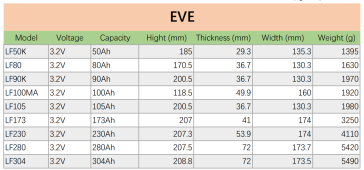I put together this table for my own interest/research, I figured it might be of interest to others as well. I am interested in comparing volumetric energy density (Watt-hours / Liter), and finding the most energy dense cells. I have also included Watt-hours / kilogram, because, why not. If you would like to contribute see comment #3
*H2 = height of cell including terminal and/or stud, all calculations except Frey and CATL are based on H not H2
**CATL and FREY aren't an apples-apples comparison with the other cells. They measure weight and height differently in a way that makes them appear less energy dense than their competitors (they only list H2 (height including terminals) and measure weight as "less than or equal to x" whereas other manufacturers list "x plus or minus y"
| Ah | Wh | Wh/kg | Wh/l | L | W | H | H2* | liters | kg | Model | |
|---|---|---|---|---|---|---|---|---|---|---|---|
| CATL* | 302 | 966.4 | 175.4 | 374.3 | 173.93 | 71.65 | 207.2* | 2.582* | 5.51** | LEP71H3L7 | |
| EVE | 304 | 972.8 | 177.2 | 380.7 | 173.50 | 72.00 | 204.50 | 208.8 | 2.555 | 5.49 | LF304 |
| EVE | 280 | 896 | 165.3 | 350.1 | 173.70 | 72.00 | 204.60 | 207.5 | 2.559 | 5.42 | LF280K |
| REPT | 280 | 896 | 167.8 | 351.9 | 173.93 | 71.55 | 204.59 | 217.1 | 2.546 | 5.34 | CB71173204EB-280Ah |
| EVE | 230 | 736 | 179.1 | 384.1 | 173.93 | 53.85 | 204.60 | 207.1 | 1.916 | 4.11 | LF230 |
| CALB | 230 | 736 | 173.6 | 384.9 | 173.93 | 53.72 | 204.63 | 217.9 | 1.912 | 4.24 | L173F230B |
| ETC | 228 | 729.6 | 173.7 | 380.0 | 174.60 | 53.80 | 204.40 | 207.3 | 1.920 | 4.20 | EC-AU228 |
| FREY | 110 | 352 | 123.5 | 259.4 | 130.00 | 36.00 | 290.0 | 1.357* | 2.85** | ||
| Ganfeng | 100 | 320 | 139.1 | 300.5 | 173.90 | 48.00 | 127.60 | 132.2 | 1.065 | 2.30** |
*H2 = height of cell including terminal and/or stud, all calculations except Frey and CATL are based on H not H2
**CATL and FREY aren't an apples-apples comparison with the other cells. They measure weight and height differently in a way that makes them appear less energy dense than their competitors (they only list H2 (height including terminals) and measure weight as "less than or equal to x" whereas other manufacturers list "x plus or minus y"
Last edited:



